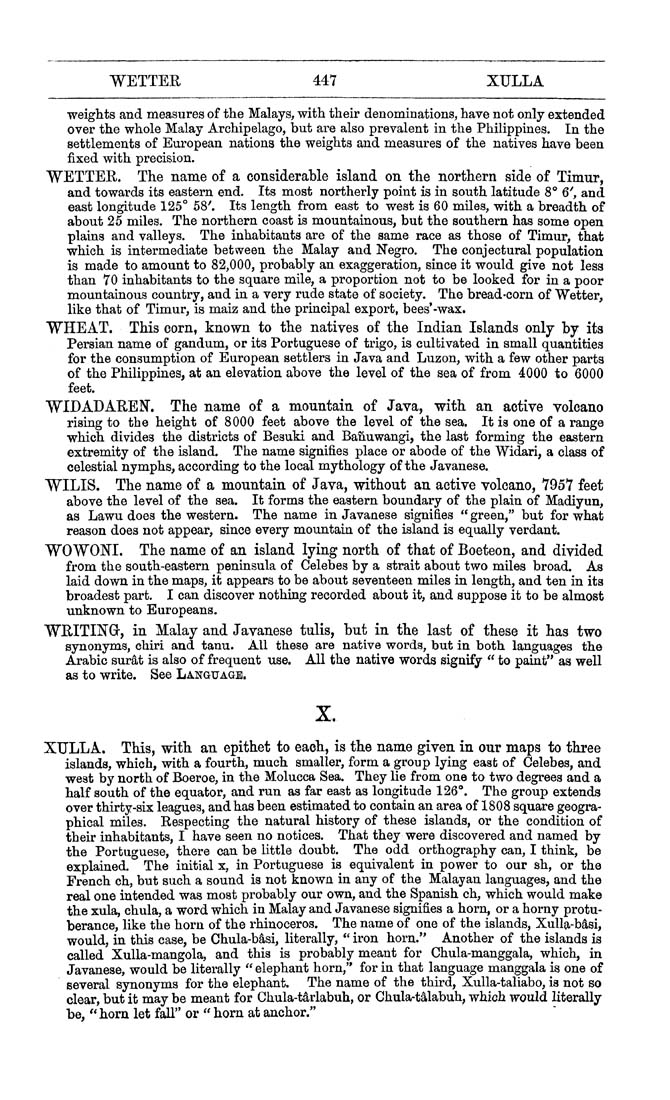WETTER 447 XULLA
weights and measures of the Malays, with their denominations, have not only extended
over the whole Malay Archipelago, but are also prevalent in the Philippines. In the
settlements of European nations the weights and measures of the natives have been
fixed with precision.
WETTER. The name of a considerable island on the northern side of Timur,
and towards its eastern end. Its most northerly point is in south latitude 8° 6\ and
east longitude 125° 58'. Its length from east to west is 60 miles, with a breadth of
about 25 miles. The northern coast is mountainous, but the southern has some open
plains and valleys. The inhabitants are of the same race as those of Timur, that
which is intermediate between the Malay and Negro. The conjectural population
is made to amount to 82,000, probably an exaggeration, since it would give not less
than 70 inhabitants to the square mile, a proportion not to be looked for in a poor
mountainous country, and in a very rude state of society. The bread-corn of Wetter,
like that of Timur, is maiz and the principal export, bees'-wax.
WHEAT. This corn, known to the natives of the Indian Islands only by its
Persian name of gandum, or its Portuguese of trigo, is cultivated in small quantities
for the consumption of European settlers in Java and Luzon, with a few other parts
of the Philippines, at an elevation above the level of the sea of from 4000 to 6000
feet.
WIDADAREN. The name of a mountain of Java, with an active volcano
rising to the height of 8000 feet above the level of the sea. It is one of a range
which divides the districts of Besuki and Banuwangi, the last forming the eastern
extremity of the island. The name signifies place or abode of the Widari, a class of
celestial nymphs, according to the local mythology of the Javanese.
WILIS. The name of a mountain of Java, without an active volcano, 7957 feet
above the level of the sea. It forms the eastern boundary of the plain of Madiyun,
as Lawu does the western. The name in Javanese signifies " green," but for what
reason does not appear, since every mountain of the island is equally verdant.
WOWONI. The name of an island lying north of that of Boeteon, and divided
from the south-eastern peninsula of Celebes by a strait about two miles broad. As
laid down in the maps, it appears to be about seventeen miles in length, and ten in its
broadest part. I can discover nothing recorded about it, and suppose it to be almost
unknown to Europeans.
WRITING-, in Malay and Javanese tulis, but in the last of these it has two
synonyms, chiri and tanu. All these are native words, but in both languages the
Arabic sur4t is also of frequent use. All the native words signify " to paint" as well
as to write. See Language.
X.
XULLA. This, with an epithet to each, is the name given in our maps to three
islands, which, with a fourth, much smaller, form a group lying east of Celebes, and
west by north of Boeroe, in the Molucca Sea. They lie from one to two degrees and a
half south of the equator, and run as far east as longitude 126". The group extends
over thirty-six leagues, and has been estimated to contain an area of 1808 square geogra¬
phical miles. Respecting the natural history of these islands, or the condition of
their inhabitants, I have seen no notices. That they were discovered and named by
the Portuguese, there can be little doubt. The odd orthography can, I think, be
explained. The initial x, in Portuguese is equivalent in power to our sh, or the
French ch, but such a sound is not known in any of the Malayan languages, and the
real one intended was most probably our own, and the Spanish ch, which would make
the xula, chula, a word which in Malay and Javanese signifies a horn, or a horny protu¬
berance, like the horn of the rhinoceros. The name of one of the islands, Xulla-b^si,
would, in this case, be Chula-b4si, literally, " iron horn." Another of the islands is
called Xulla-mangola, and this is probably meant for Chula-manggala, which, in
Javanese, would be literally " elephant horn," for in that language manggala is one of
several synonyms for the elephant. The name of the third, Xulla-taliabo, is not so
clear, but it may be meant for Chula-t^rlabuh, or Ghula-t^labuh, which would literally
be, " horn let fall" or " horn at anchor."
|








